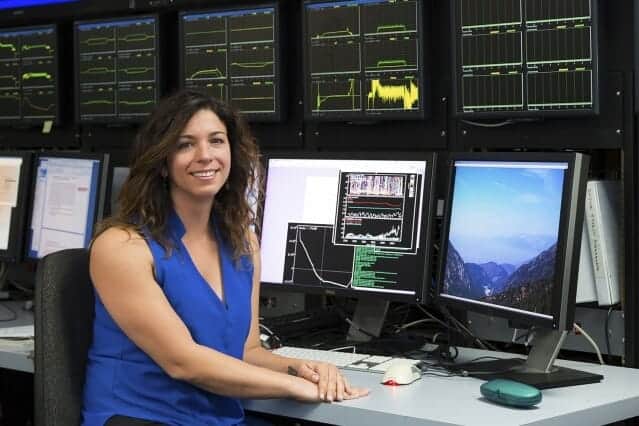“In some ways you can compare what we are trying to do to self-driving cars.”
MIT postdoc Cristina Rea is describing her work at the Institute’s Plasma Science and Fusion Center (PSFC), where she is exploring ways to predict disruptions in the turbulent plasma that fuels fusion tokamak reactors..
“You want to be able to predict when an object presents an obstacle for your car,” she continues with her comparison. “Likewise, in fusion devices, you need to be able to predict disruptions, with enough warning time so you can take actions to avoid a problem.”
Tokamaks use magnetic fields to contain hot plasma in a donut-shaped vacuum chamber long enough for fusion to occur. Chaotic and unpredictable, the plasma resists confinement, and disrupts. Timely predictions about incipient plasma disruptions could help sustain fusion energy production in these devices, while preventing damage to the machine.
To tackle the issue, Rea is part of the PSFC’s collaboration with the DIII-D tokamak in San Diego, which, since the Center’s Alcator C-Mod device ended its run in September 2016, is the only fusion-grade tokamak in the U.S. that is currently running. With PSFC research scientist Bob Granetz, she is developing a database to centralize information about disruptions in C-Mod, DIII-D, and other tokamaks around the world. Employing machine learning techniques to model how disruptions are likely to progress, she hopes to use these data to find ways to mitigate the problem.
Her interest in plasma science developed at the University of Padua, where as a graduate student she was able to gain experience doing research at Italy’s Reversed Field Pinch fusion experiment. She graduated with a PhD in physics in 2015. So it felt like a detour when she found herself accepting a position as a data scientist with one of Italy’s largest banks.
“UniCredit was looking for a PhD that could learn fast, and so they let me have some hands-on training in machine learning techniques, such as the ones used to improve the customer relationship management. We used bank customers’ account and credit card data to predict the probability that a particular customer would close the account and abandon the bank.”
Although genuinely intrigued by the specific techniques used to explore and analyze data, she notes, “the subject itself was not what I studied, what I loved.”
She decided, with her husband, who is also a plasma physicist, “to give research another shot.” Together they began exploring opportunities outside of Italy. When her husband received a postdoctoral position at General Atomics (GA) in San Diego, Rea turned her attention towards the local opportunities, including DIII-D, which is housed at GA. There she discovered the perfect project for her talents.
MIT research scientist Bob Granetz, collaborating at DIII-D, needed a postdoc versed in plasma physics to help centralize data about tokamak plasma disruptions, in preparation for analyzing the data further with machine learning.
“I knew the methods,” says Rea, “though in an entirely different context. That was one lucky shot!”
Despite a wealth of knowledge gathered from fusion and plasma devices, no consistent or solid theory of the disruption process has yet been developed.
“Disruptions are complicated phenomena, and we don’t have sufficient theoretical understanding to be able to calculate when a disruption is approaching,” says supervisor Granetz. “Although we have huge amounts of empirical data, it’s difficult for us to recognize the necessary disruption-relevant information that we believe is contained in the data. This is exactly the kind of situation that machine learning is tailored for: Take a few algorithms that are good at recognizing patterns in data, train the algorithms on our large databases of disruption-relevant data, and see if something useful comes out.”
Rea is excited to apply some of the machine learning techniques she acquired in banking to this complex problem. Being on site at DIII-D allows Rea to gather data on the major working tokamak in the U.S., and to be ready to test any promising algorithms on the tokamak in real time. Her recent research compares data from DIII-D and C-Mod in order to create an algorithm for predicting disruptions that would be broadly applicable to other tokamaks, including ITER, the next-generation fusion device being built in France, and, SPARC, the PSFC’s compact, high-field, net fusion energy experiment. Her early results have indicated that the chosen algorithm has wildly different predictive success on each device, with the success on C-Mod actually being worse than a random guess.
“DIII-D has had the better results so far in terms of reliable predictions and we were able to develop a robust model, given the experimental data available. C-Mod has shown completely different disruption dynamics, and we are actively working to develop an algorithm capable of both capturing these dynamics and at the same time reliably generalizing to unseen cases.”
Rea is more energized than deterred by the challenge of developing cutting-edge machine learning tools that will eventually provide a process for consistent predictions. She has always loved a challenge, deciding in college on a physics major instead of English literature because it posed more questions that she wanted to answer.
“In college I was first interested in physics from a theoretical point of view. Then I switched to plasma. Every time I switched to a different topic it was because I needed more questions. I needed more problems.” She laughs as she questions, “What’s going to really stump me?”
Fusion research will keep the questions coming.
“Plasma physics, and all the efforts going into understanding and trying to develop fusion energy — I think this is really a good task and a good question to solve. Finding out the answer to that question — how to create fusion energy on Earth — will have a major impact, not just on a limited number of people, but for all humankind.”

